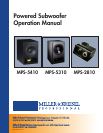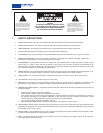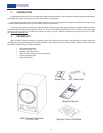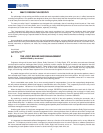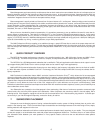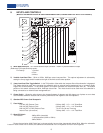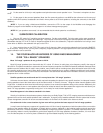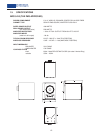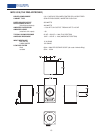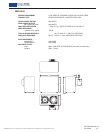
8. Do the same for all front (or main) speakers and point the meter at each speaker in turn. The meter’s microphone is direc-
tional.
9. Do the same for the surround speakers (Note: the film community prefers to use 82dB as the reference level for surround
speakers while DVD authors, broadcasters and music mixers prefer to set all their speakers, including the surrounds, to the 85dB
standard.)
(NOTE 1: if you are using a Martinsound MultiMax, connect the LFE-4 to the output of the MultiMax and disengage the
“Redirect” program on the MultiMax as this program is not a bass management program).
(NOTE 2: if your speakers are moved, it is recommended that the whole system be re-calibrated.)
13. SUBWOOFER CALIBRATION
1. Set your SPL meter for C weighting and slow response. Set the scale to 80dB. Point the meter at the center speaker at
ear height with the meter at a slightly up-turned angle. Play track two of the test CD through the selected speaker and read the SPL
(Remember that the LFE-4 will re-route all frequencies below 80 Hz to the subwoofer.) Adjust the subwoofer level using a small
screw driver to 85dB on the subwoofer trim pot on the LFE-4.
2. Next, route track two on the TEST CD to each of the 5 channels. Make sure that the subwoofer level is exactly 85dB SPL
for all channels. If they are not, you may have a frequency response problem in the signal path that will have to be corrected before
proper calibration can be achieved.
14. THE FOUR MAJOR ADVANTAGES OF USING BASS MANAGEMENT
OVER “FULL RANGE” SPEAKERS
Most “full-range” speakers do not go down to 20 Hz.
Most “full-range” speakers (even those with dual 12" or dual 15" drivers) in reality have a low frequency cutoff in the range of
40 to 50 Hz. This puts them about an octave short of the low frequency response of an M&K Professional subwoofer. Because these
speakers are the standard that is used in many studios, many modern stereo recordings have bass information below 40 Hz that
the recording engineer never heard. When these recordings are played back on a properly calibrated multichannel audio system,
the music sounds bass heavy or even worse has information in the sound track that was never intended to be there, such as noise,
equipment hum or other artifacts.
Satellite speakers are smaller and can fit in more places than “full range” speakers
Unlike two-channel stereo, multichannel audio requires that speakers be placed in very specific locations. In video post it means
placing speakers close to the sides and on top of the video monitor. In Telecine, it means fitting the center channel speaker inside
a light cove. In situations where near-field monitoring is required, it can mean three speakers sitting on the console. Additionally, the
surround speakers are two or more speakers that need to be located at least 2 feet above seated ear height on the wall above your
head. Full range speakers are generally too big and / or too heavy for most of these applications.
Bass Management is the defacto standard in the home.
Virtually all multichannel home theatre systems, whether they are Dolby Digital, THX or DTS, employ processors with bass man-
agement and use five small satellite speakers and a subwoofer. A properly set-up satellite-subwoofer monitor system that includes
a bass management controller will ensure accurate translation of work done in the studio to the listener at home.
One subwoofer in the correct location of given room will out perform the bass output of five full range speakers.
In small rooms the frequency response of a speaker below 100 Hz is heavily dependent on both the modes of the room and the
position of the speaker relative to the listener. (A simple test is to place a subwoofer in the listening position and walk around the
boundaries of the room. The bass response will dramatically change from position to position.) The modal response and the posi-
tion sensitivity makes it virtually impossible to get the bass response of 5 full-range speakers consistent. However, it is much easi-
er to find the best place in a room to place a subwoofer to give the flattest frequency at the listening position.
11



